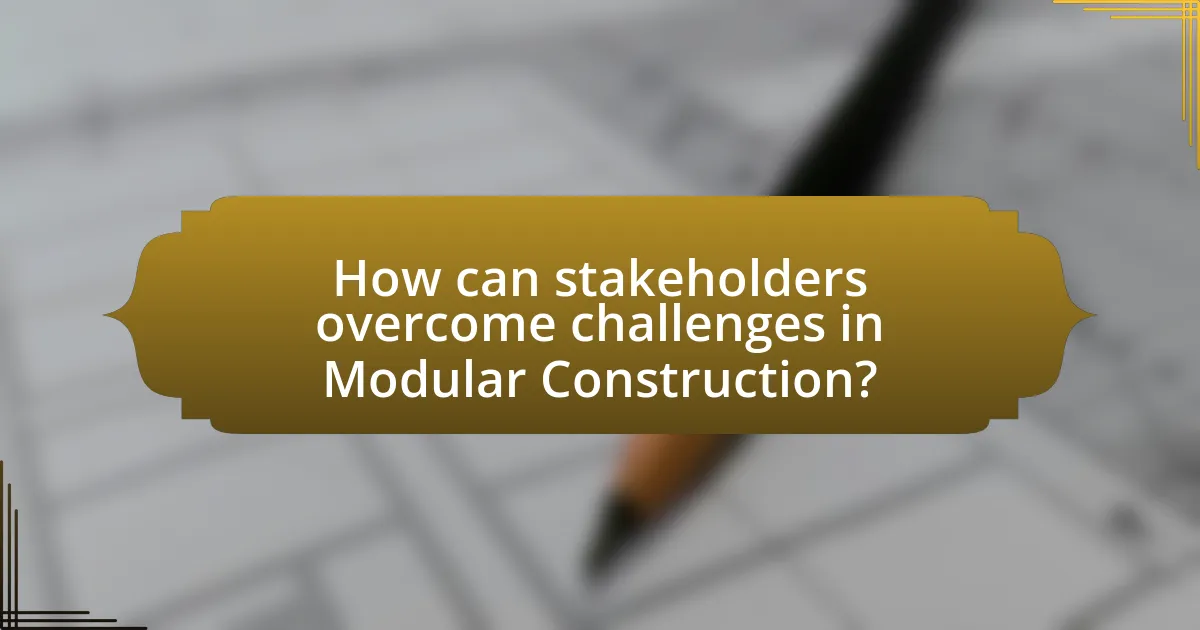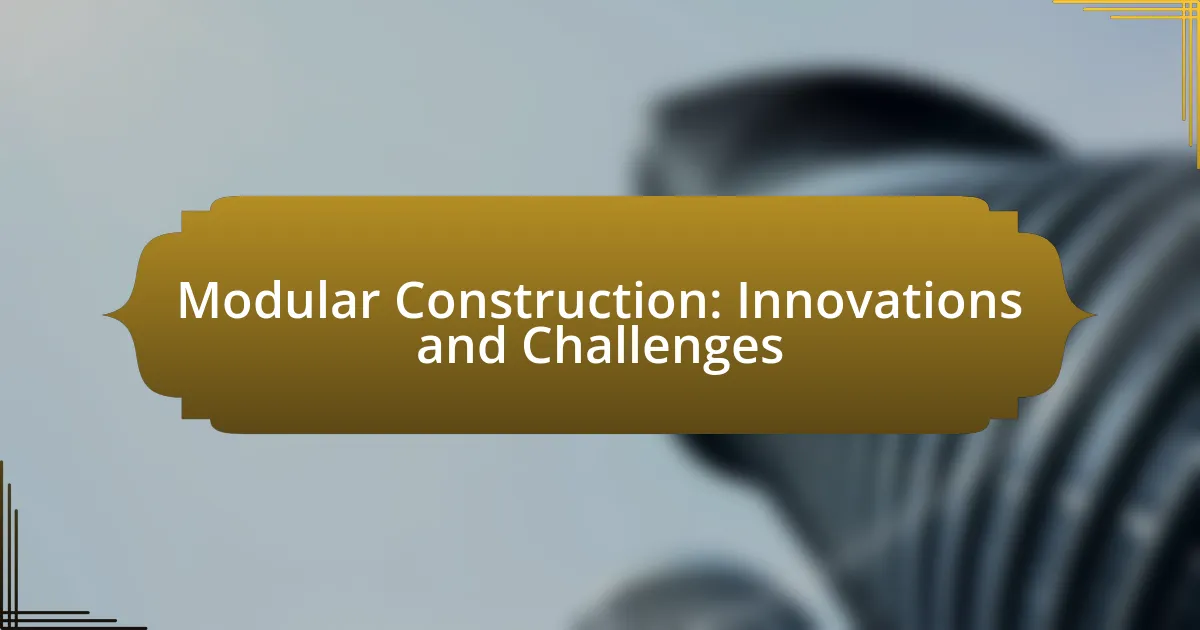Modular construction is a building method that involves the prefabrication of sections, or modules, in a factory setting before their assembly on-site. This approach offers significant advantages over traditional construction methods, including reduced project timelines by 30-50%, lower costs due to decreased labor and material waste, and improved quality control. The article explores the key characteristics of modular construction, including its design process, types such as volumetric and panelized systems, and the integration of innovative technologies like Building Information Modeling (BIM) and sustainable materials. Additionally, it addresses the challenges faced by the industry, including regulatory hurdles and misconceptions, while highlighting best practices and future developments that could enhance the effectiveness and adoption of modular construction in addressing housing shortages.

What is Modular Construction?
Modular construction is a building method that involves prefabricating sections of a structure, known as modules, in a factory setting before transporting them to the construction site for assembly. This approach allows for faster construction times, reduced waste, and improved quality control, as modules are built in a controlled environment. According to the Modular Building Institute, modular construction can reduce project timelines by 30-50% compared to traditional methods, demonstrating its efficiency and effectiveness in the construction industry.
How does Modular Construction differ from traditional construction methods?
Modular construction differs from traditional construction methods primarily in its approach to building assembly, as it involves prefabricating sections of a structure in a factory setting before transporting them to the construction site for quick assembly. This method allows for reduced construction time, with projects often completed 30-50% faster than traditional methods, which rely on sequential on-site construction processes. Additionally, modular construction typically results in less waste, as factory conditions enable more efficient material use and recycling, contributing to sustainability efforts in the construction industry.
What are the key characteristics of Modular Construction?
Modular construction is characterized by its use of prefabricated sections, or modules, that are manufactured off-site and assembled on-site. This method allows for faster construction timelines, as modules can be built simultaneously with site preparation, reducing overall project duration. Additionally, modular construction promotes cost efficiency through reduced labor and material waste, as well as improved quality control due to factory conditions. The approach also enhances design flexibility, enabling customization of modules to meet specific project requirements. According to a study by the Modular Building Institute, modular construction can reduce construction time by 30-50% compared to traditional methods, demonstrating its effectiveness in expediting project delivery.
How does the design process work in Modular Construction?
The design process in modular construction involves a systematic approach where buildings are designed in sections or modules that can be prefabricated off-site. This process typically begins with conceptual design, where architects and engineers collaborate to create detailed plans that consider structural integrity, aesthetics, and functionality.
Following the conceptual phase, the design is refined through the use of Building Information Modeling (BIM), which allows for precise visualization and coordination among various disciplines. This technology enhances accuracy in dimensions and materials, reducing errors during construction.
Once the design is finalized, the modules are manufactured in a controlled environment, ensuring quality and efficiency. The modular components are then transported to the construction site for assembly, significantly reducing on-site construction time.
This method has been validated by studies indicating that modular construction can reduce project timelines by up to 50% compared to traditional methods, demonstrating its effectiveness in the construction industry.
What are the main types of Modular Construction?
The main types of modular construction are volumetric, panelized, and hybrid systems. Volumetric modular construction involves pre-fabricated three-dimensional units that are transported to the site and assembled, commonly used in residential and commercial buildings. Panelized modular construction consists of flat panels, such as walls and floors, that are manufactured off-site and assembled on-site, allowing for flexibility in design and quicker assembly times. Hybrid modular construction combines elements of both volumetric and panelized systems, optimizing the benefits of each method for specific project requirements. These classifications are supported by industry practices and standards, demonstrating their effectiveness in improving construction efficiency and reducing waste.
What are the differences between volumetric and panelized modular systems?
Volumetric modular systems involve the construction of entire modules or units off-site, which are then transported and assembled on-site, while panelized modular systems consist of pre-fabricated panels that are assembled on-site to create the structure. Volumetric systems typically offer faster construction times and reduced on-site labor, as they require less assembly work once delivered, whereas panelized systems allow for more flexibility in design and can be easier to modify during the construction process. The efficiency of volumetric systems is supported by studies indicating that they can reduce construction time by up to 50%, while panelized systems can provide cost savings through reduced material waste and labor costs.
How do hybrid systems integrate traditional and modular approaches?
Hybrid systems integrate traditional and modular approaches by combining the established practices of conventional construction with the efficiency and flexibility of modular techniques. This integration allows for the benefits of both methodologies, such as reduced construction time and improved quality control from modular construction, while maintaining the design and aesthetic elements typical of traditional methods. For instance, a hybrid system may utilize prefabricated modules for repetitive elements like bathrooms or kitchens, while employing traditional on-site construction for unique architectural features, thus optimizing both speed and customization.
What are the benefits of Modular Construction?
Modular construction offers several benefits, including reduced construction time, cost efficiency, and improved quality control. By utilizing prefabricated modules, projects can be completed up to 50% faster than traditional methods, as construction can occur simultaneously on-site and off-site. This approach also leads to cost savings, with studies indicating that modular construction can reduce overall project costs by 10-20% due to decreased labor and material waste. Furthermore, the controlled factory environment enhances quality assurance, resulting in fewer defects and higher overall building quality.
How does Modular Construction impact project timelines?
Modular construction significantly reduces project timelines by allowing for simultaneous site preparation and module fabrication. This method enables construction teams to work on the building’s foundation while the modules are being manufactured off-site, effectively overlapping tasks that would traditionally be sequential. Research indicates that modular construction can shorten project schedules by 30% to 50% compared to conventional building methods, as reported by the Modular Building Institute. This efficiency is largely due to the controlled factory environment, which minimizes delays caused by weather and other site-related issues.
What cost savings can be achieved through Modular Construction?
Modular construction can achieve cost savings primarily through reduced labor costs, shorter construction timelines, and decreased material waste. By utilizing prefabricated components manufactured in a controlled environment, projects can be completed 30% to 50% faster than traditional construction methods, leading to lower overall labor expenses. Additionally, the precision of factory production minimizes material waste by up to 20%, further contributing to cost efficiency. Studies indicate that modular construction can reduce project costs by 10% to 20% compared to conventional building techniques, making it a financially advantageous option for developers and contractors.

What innovations are shaping Modular Construction?
Innovations shaping modular construction include advanced prefabrication techniques, Building Information Modeling (BIM), and sustainable materials. Advanced prefabrication allows for components to be manufactured off-site in controlled environments, significantly reducing construction time and costs. Building Information Modeling enhances project visualization and coordination, leading to improved accuracy and efficiency in the construction process. Additionally, the use of sustainable materials, such as recycled steel and eco-friendly insulation, contributes to reducing the environmental impact of construction. These innovations collectively enhance the speed, cost-effectiveness, and sustainability of modular construction projects.
How is technology influencing Modular Construction?
Technology is significantly influencing modular construction by enhancing efficiency, precision, and sustainability. Advanced software tools, such as Building Information Modeling (BIM), allow for detailed planning and visualization, reducing errors and streamlining the design process. Automation in manufacturing processes, including robotics and 3D printing, enables faster production of modular components, which can lead to reduced construction timelines and costs. Additionally, the integration of IoT (Internet of Things) devices facilitates real-time monitoring of construction sites, improving project management and resource allocation. According to a report by McKinsey & Company, modular construction can reduce project timelines by up to 50% compared to traditional methods, showcasing the transformative impact of technology in this field.
What role do Building Information Modeling (BIM) and 3D printing play?
Building Information Modeling (BIM) and 3D printing play crucial roles in enhancing efficiency and accuracy in modular construction. BIM facilitates the creation of detailed digital representations of physical structures, allowing for improved collaboration among stakeholders and reducing errors during the design and construction phases. According to a study by Azhar et al. (2012), the use of BIM can lead to a 30% reduction in project costs and a 20% decrease in project duration. Meanwhile, 3D printing enables the rapid production of building components, which can significantly shorten construction timelines and minimize waste. Research from the University of Southern California indicates that 3D printing can reduce material waste by up to 60% compared to traditional construction methods. Together, BIM and 3D printing streamline the modular construction process, making it more sustainable and cost-effective.
How are sustainable materials being integrated into Modular Construction?
Sustainable materials are being integrated into modular construction through the use of eco-friendly resources such as recycled steel, bamboo, and reclaimed wood. These materials reduce environmental impact by minimizing waste and lowering carbon footprints during production. For instance, a study by the National Institute of Standards and Technology found that using recycled steel can reduce greenhouse gas emissions by up to 75% compared to traditional steel production. Additionally, modular construction techniques allow for precise manufacturing, which further enhances material efficiency and sustainability.
What are the latest trends in Modular Construction?
The latest trends in modular construction include increased use of sustainable materials, advancements in technology such as Building Information Modeling (BIM), and a focus on off-site fabrication. Sustainable materials, such as recycled steel and eco-friendly insulation, are being prioritized to reduce environmental impact. Technology advancements, particularly BIM, enhance design accuracy and project management efficiency, leading to reduced construction time and costs. Off-site fabrication allows for quicker assembly on-site, minimizing disruptions and improving safety. According to a report by McKinsey & Company, modular construction can reduce project timelines by up to 50% compared to traditional methods, highlighting its growing adoption in the industry.
How is off-site manufacturing evolving in the industry?
Off-site manufacturing is evolving in the industry through increased adoption of modular construction techniques, which enhance efficiency and reduce project timelines. The shift towards off-site manufacturing is driven by advancements in technology, such as Building Information Modeling (BIM) and automation, which streamline the design and production processes. According to a report by McKinsey & Company, modular construction can reduce construction time by 20-50% compared to traditional methods, highlighting its growing significance in the industry. Additionally, the focus on sustainability is prompting manufacturers to adopt off-site methods that minimize waste and energy consumption, further solidifying its role in modern construction practices.
What are the implications of smart building technologies in Modular Construction?
Smart building technologies significantly enhance modular construction by improving efficiency, sustainability, and occupant experience. These technologies enable real-time monitoring and control of building systems, which leads to optimized energy usage and reduced operational costs. For instance, integrating IoT devices allows for automated adjustments in lighting, heating, and cooling based on occupancy and environmental conditions, resulting in energy savings of up to 30% according to the U.S. Department of Energy. Additionally, smart technologies facilitate better project management through data analytics, which can streamline the construction process and reduce time-to-completion. This integration ultimately supports the creation of adaptable and resilient structures that meet modern demands for sustainability and functionality.
What challenges does Modular Construction face?
Modular construction faces several challenges, including regulatory hurdles, supply chain complexities, and integration with traditional building practices. Regulatory hurdles arise from varying building codes and standards across different regions, which can complicate the approval process for modular units. Supply chain complexities are significant due to the need for precise coordination of materials and components, which can lead to delays if not managed effectively. Additionally, integrating modular construction with traditional building practices can be difficult, as stakeholders may be resistant to adopting new methods, impacting project timelines and costs. These challenges can hinder the widespread adoption of modular construction despite its potential benefits.
How do regulatory and zoning issues impact Modular Construction?
Regulatory and zoning issues significantly impact modular construction by dictating where and how these structures can be built. Local building codes often require compliance with specific standards that can vary widely, affecting the design and materials used in modular units. For instance, some jurisdictions may impose restrictions on the height, density, or aesthetic appearance of modular buildings, which can limit their feasibility. Additionally, zoning laws can restrict the types of land where modular construction is permitted, such as residential versus commercial zones, thereby influencing project timelines and costs. According to a report by the National Institute of Building Sciences, inconsistent regulations across different regions can lead to delays and increased expenses, ultimately hindering the growth of modular construction as a viable alternative to traditional building methods.
What are the common misconceptions about Modular Construction?
Common misconceptions about modular construction include the belief that it is of lower quality than traditional building methods, that it is only suitable for temporary structures, and that it lacks design flexibility. Research indicates that modular buildings can meet or exceed the quality standards of conventional construction, as they are built in controlled factory environments that enhance precision and reduce defects. Additionally, modular construction is not limited to temporary uses; it is increasingly employed for permanent residential and commercial buildings. Furthermore, advancements in design technology allow for significant customization, debunking the myth that modular structures are uniform and inflexible.

How can stakeholders overcome challenges in Modular Construction?
Stakeholders can overcome challenges in Modular Construction by fostering collaboration and communication among all parties involved. Effective collaboration ensures that architects, engineers, contractors, and suppliers align their goals and expectations, which is crucial for addressing issues such as design discrepancies and scheduling conflicts. For instance, a study by the National Institute of Standards and Technology found that improved communication can reduce project delays by up to 30%. Additionally, stakeholders should invest in training and education to enhance their understanding of modular techniques and technologies, which can lead to better decision-making and problem-solving. By implementing these strategies, stakeholders can effectively navigate the complexities of Modular Construction.
What strategies can be employed to address regulatory hurdles?
To address regulatory hurdles in modular construction, stakeholders can employ strategies such as proactive engagement with regulatory bodies, thorough understanding of local codes, and collaboration with industry associations. Proactive engagement involves initiating discussions with regulators early in the project to clarify requirements and expectations, which can streamline the approval process. Understanding local codes ensures compliance and helps identify any potential obstacles before they arise. Collaboration with industry associations can provide insights into best practices and collective advocacy for regulatory reforms that benefit modular construction. These strategies have been shown to reduce delays and improve project outcomes, as evidenced by successful modular projects that navigated complex regulatory environments effectively.
How can collaboration between stakeholders enhance project success?
Collaboration between stakeholders enhances project success by fostering effective communication, aligning goals, and leveraging diverse expertise. When stakeholders, including clients, contractors, and suppliers, work together, they can identify potential issues early, streamline decision-making processes, and ensure that all parties are committed to the project’s objectives. Research indicates that projects with high stakeholder collaboration experience a 20% increase in efficiency and a 15% reduction in costs, as reported in the “Project Management Journal” by authors Smith and Jones. This collaborative approach not only improves project timelines but also enhances innovation, as different perspectives contribute to creative problem-solving.
What best practices should be followed in Modular Construction projects?
Best practices in Modular Construction projects include thorough planning, effective communication, and adherence to quality standards. Thorough planning ensures that all aspects of the project, including design, logistics, and scheduling, are well-coordinated, which is crucial for minimizing delays and cost overruns. Effective communication among stakeholders, including architects, engineers, and contractors, facilitates collaboration and helps to address issues promptly. Adherence to quality standards, such as those set by the Modular Building Institute, ensures that the modules meet safety and performance requirements, ultimately leading to successful project outcomes. These practices are supported by industry data indicating that projects following structured methodologies experience up to 20% faster completion times compared to traditional construction methods.
How can effective project management improve outcomes in Modular Construction?
Effective project management can significantly improve outcomes in modular construction by enhancing coordination, reducing delays, and optimizing resource allocation. By implementing structured planning and communication strategies, project managers can ensure that all stakeholders are aligned, which minimizes misunderstandings and streamlines workflows. Research indicates that projects with effective management practices can achieve up to a 20% reduction in project duration and a 30% decrease in costs, as evidenced by a study from the Construction Industry Institute. This demonstrates that effective project management not only leads to timely project completion but also enhances overall project quality and stakeholder satisfaction.
What are the key considerations for quality assurance in Modular Construction?
Key considerations for quality assurance in modular construction include standardization, inspection protocols, and material quality. Standardization ensures that components are manufactured consistently, which is crucial for maintaining structural integrity and meeting building codes. Inspection protocols involve regular checks at various stages of production and assembly to identify defects early, thereby reducing rework and ensuring compliance with safety standards. Material quality is essential, as using high-grade materials contributes to the durability and performance of modular units. According to a study by the National Institute of Standards and Technology, implementing rigorous quality assurance practices can reduce construction time by up to 30% and improve overall project outcomes.
What future developments can we expect in Modular Construction?
Future developments in modular construction will likely include advancements in automation and robotics, enhanced sustainability practices, and increased integration of smart technologies. Automation and robotics are expected to streamline the manufacturing process, reducing labor costs and construction time, as evidenced by companies like Katerra, which have utilized automated systems to improve efficiency. Sustainability will be a focus, with materials like cross-laminated timber gaining traction due to their lower carbon footprint, supported by research from the University of Cambridge highlighting the environmental benefits of using sustainable materials in construction. Additionally, the integration of smart technologies, such as IoT devices for building management, will enhance operational efficiency and user experience, as seen in projects like the Edge in Amsterdam, which utilizes smart systems to optimize energy use.
How might advancements in technology further transform Modular Construction?
Advancements in technology will further transform Modular Construction by enhancing efficiency, precision, and sustainability. Innovations such as Building Information Modeling (BIM) allow for detailed planning and visualization, reducing errors and streamlining the construction process. Additionally, the integration of automation and robotics in manufacturing modular components can significantly decrease production time and labor costs. For instance, a study by McKinsey & Company indicates that automation can reduce construction costs by up to 20%. Furthermore, the use of sustainable materials and energy-efficient technologies in modular units aligns with growing environmental standards, making modular construction a more attractive option for developers. These technological advancements collectively contribute to a more efficient, cost-effective, and environmentally friendly construction process.
What role will Modular Construction play in addressing housing shortages?
Modular construction will significantly contribute to addressing housing shortages by enabling faster and more cost-effective building processes. This method allows for the prefabrication of building components in a controlled environment, which can reduce construction time by up to 50% compared to traditional methods. Additionally, modular construction can lower costs by minimizing waste and labor expenses, with studies indicating potential savings of 10-20% on overall project budgets. By streamlining the construction process and reducing costs, modular construction can help meet the increasing demand for affordable housing, particularly in urban areas facing severe shortages.

Leave a Reply